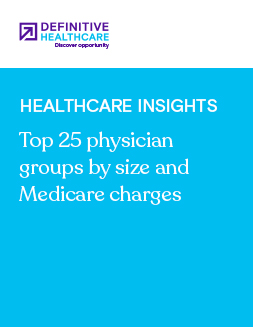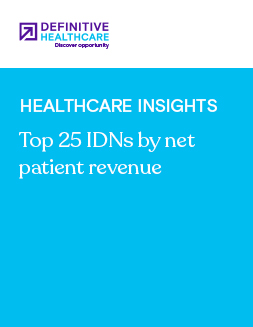Healthcare Insights
How many surgery centers are in each state?
When a patient needs surgery that requires overnight observation or a guided inpatient recovery, the hospital has the resources and personnel necessary to ensure the best outcome. But for routine, less intensive surgical procedures, ambulatory surgical centers (ASCs) offer a cost-effective, safe alternative to the hospital.
Also known as outpatient surgery centers, these modern medical facilities specialize in surgical procedures and services that don’t require an overnight stay.
Using data from Definitive Healthcare’s SurgeryCenterView product, we’ve determined the number of ASCs in each U.S. state. Keep reading to see which states have the most ASCs, and which have the fewest.
Number of ambulatory surgery centers in the U.S. by state
State | ASC count |
|---|---|
California | 1,271 |
Texas | 801 |
Florida | 797 |
Georgia | 574 |
Maryland | 449 |
New York | 405 |
Pennsylvania | 391 |
New Jersey | 352 |
Ohio | 340 |
Arizona | 328 |
North Carolina | 306 |
Washington | 286 |
Michigan | 235 |
Illinois | 230 |
Indiana | 221 |
Tennessee | 212 |
Colorado | 201 |
Virginia | 197 |
Missouri | 162 |
Louisiana | 159 |
South Carolina | 139 |
Wisconsin | 133 |
Minnesota | 131 |
Massachusetts | 127 |
Oregon | 125 |
Nevada | 110 |
Connecticut | 110 |
Arkansas | 103 |
Mississippi | 99 |
Kansas | 98 |
Alabama | 92 |
Utah | 91 |
Idaho | 87 |
Kentucky | 86 |
Oklahoma | 82 |
Nebraska | 74 |
New Mexico | 47 |
Iowa | 45 |
Montana | 37 |
New Hampshire | 36 |
Hawaii | 35 |
North Dakota | 34 |
Delaware | 28 |
South Dakota | 27 |
West Virginia | 24 |
Wyoming | 23 |
Rhode Island | 23 |
Alaska | 23 |
Maine | 20 |
District of Columbia | 10 |
Vermont | 4 |
Fig. 1 – Number of active ambulatory surgery centers using data from our SurgeryCenterView product. Data accessed October 2025.
States with the most ambulatory surgery centers (ASCs)
| Rank | State | ASC count |
| 1 | California | 1,271 |
| 2 | Texas | 801 |
| 3 | Florida | 797 |
| 4 | Georgia | 574 |
| 5 | Maryland | 449 |
| 6 | New York | 405 |
| 7 | Pennsylvania | 391 |
| 8 | New Jersey | 352 |
| 9 | Ohio | 340 |
Fig. 2 – States with the most active ambulatory surgery centers using data from our SurgeryCenterView product. Data accessed October 2025.
Which states have the most ASCs?
California (1,271), Texas (801), and Florida (797) lead the nation in the number of ASCs. These states combine large populations, dense urban hubs, and relatively business-friendly regulatory environments that make it easier for ASCs to thrive.
Which states have the fewest ASCs?
At the other end of the spectrum, states like Vermont (4), Maine (20), and Alaska (23) have the fewest ASCs. Smaller populations, lower procedure volumes, and more restrictive oversight, particularly certificate of need (CON) laws, likely limit their growth.
There is empirical support for the idea that removing CON restrictions leads to increased ASC proliferation: a 2024 study estimates that repealing ASC-related CON laws leads to a 44–47% increase in ASCs per capita statewide, and even larger gains in rural areas (92-112%).
What are the benefits of ASCs?
ASCs are suitable for a variety of routine outpatient procedures ranging from colonoscopies to cataract surgeries to upper GI imaging. Because patients undergoing these procedures recover at home, they experience less exposure to bacteria and viruses from other patients and staff. This leads to a measurably lower incidence of surgical site infections, which is part of the reason care seems to be shifting from hospitals to ASCs.
Cost savings are another benefit of surgery centers. Without staff or resources for overnight observation, ASCs have less overhead than hospitals and often pass those savings on in procedure costs. Plus, most ASCs focus on a single specialty, further reducing operational costs.
For patients in decent health (i.e., with few comorbidities) and with limited risk of complications, ASCs offer a cheaper, more seamless surgical care experience than the average hospital.
How to use ASC data for healthcare sales and marketing
As the U.S. healthcare system shifts more procedures from hospitals to outpatient settings, ASCs have become a major growth engine. For healthcare companies, ASC data can show where procedures are being performed, where markets are expanding or contracting, and how to reach key decision-makers.
States like California, Texas, and Florida lead the nation in ASC volume, reflecting both population size and a favorable business climate. By contrast, states with stricter CON laws or smaller populations, like Vermont or Maine, have far fewer centers.
Knowing this helps commercial teams focus resources in regions with the greatest potential for new partnerships, sales, and adoption.
ASCs also differ by specialty, ownership, and size. A GI center might operate differently from an orthopedic one, and a hospital-affiliated ASC has different procurement processes than a physician-owned practice. Combining ASC data with procedure or ownership details allows marketers to:
- Prioritize the most relevant facilities for their product category
- Tailor outreach based on workflow and economic drivers
- Anticipate purchasing behavior at both chain and independent centers
Data on ASC locations and procedure volumes can also help sales leaders design smarter territories and allocate field teams efficiently. Reps can target clusters of high-volume ASCs, plan travel routes strategically, and focus on centers most likely to convert, reducing wasted effort while improving account coverage.
In short, ASC data connects strategy to reality. It shows where care is happening, how regulations shape opportunity, and which areas are primed for growth. For sales and marketing teams, leveraging this data means moving from broad campaigns to precise, data-driven engagement.
For more of the latest ASC trends, check out the largest ambulatory surgery centers by operating rooms and the top outpatient procedures performed between hospitals and ASCs.
Learn more
Healthcare Insights are developed with healthcare commercial intelligence from the Definitive Healthcare platform. Want even more insights? Start a free trial now and get access to the latest healthcare commercial intelligence on hospitals, physicians, and other healthcare providers.


